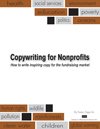I’m hoping the answer is “NO.”
In his blog “Future Fundraising Now,” Jeff Brooks shares his thoughts on a blog post from an aid worker in Ethiopia: Owen Barder. I agree wholeheartedly with Jeff and here I’ll throw in my 2¢ worth.
Essentially, Owen disagrees with the need to make a personal connection between donors and those they help. His experience is that it requires the beneficiaries of the aid to share their stories. He refers to this as “prostituting” themselves.
Here’s an excerpt from Owen’s post:
“…a broader problem, with the citizens of rich countries, who seem to be unwilling to sacrifice a tiny part of their income to help a fellow human being unless they feel some sort of personal connection with the recipient. This is charity of a Dickensian sort: not a system of social justice and protection, but throwing some coins to a beggar in the street and expecting to be lavishly thanked.
Quenching the appetite for poverty porn is rational for each charity, NGO and aid agency: that is what they need to do to survive; but it is socially harmful. We have to work harder to convince the public to make contributions without the titillation of letters from children or logos on lorries, but based on systematic and rigorous evidence of the difference that their contributions are making.” [Note: I put some of Owen’s words in bold myself to draw your attention to them.]
Personal connections are essential. And the challenge is that very, very, very few Americans have any concept of the level of poverty people in developing nations face. It’s two, three or more levels worse than what the poor face here at home.
Now I’m NOT diminishing the hardships of my fellow Americans! My point is that it takes extra effort to get people to understand the severity and depth of the poverty in other countries. Unless you’ve seen some of it first hand – which I have and I don’t mean on TV – it really is hard to grasp the full impact of the tragedy. There’s nothing like it in our country and we’re very blessed this way.
That doesn’t mean we don’t care. The U.S. is the most generous country on earth when it comes to supporting nonprofits and disaster relief.
Nonetheless, if you just present a factual summation of the problem . . . some cold systematic and rigorous evidence then your charity will receive funding. But to receive more funding and to keep donors giving they must have a personal connection. And it is possible to make a strong connection without asking the children to write the letters.
For example: Whenever my clients are able to provide the framework of a story I’m thrilled. I take the information skeleton and go to work. This is because I love to open with a story about one person – child or adult – who needs help. I want to give them a name – Ethan – and succinctly tell their story by painting a vivid picture for the donor. Then I share how a gift from someone like you made a difference in Ethan’s life. Here’s what he enjoys today, thanks to you. The donor connects with Ethan one-on-one.
Why do I enjoy this technique so much? I know there’s a sweet increase in response rates when I’m given free reign to write fundraising letters this way. And at imes I’ve also seen the average gift size increase with the response rate.
If you merely talk about people in general. If you cite statistics such as 10,000 suffering without enough food…you will raise money. But you’ll raise MORE when you make a personal connection between one person in need and one donor.
I don’t have Owen’s front line experience. Yet I do know what it takes to raise funds for charities. Helping donors see the personal human experience of need and suffering is not “prostituting” the needy in my opinion. It’s serving mankind.
Here’s another link to Jeff Brook’s blog where you can also connect to Owen Barder’s blog.
